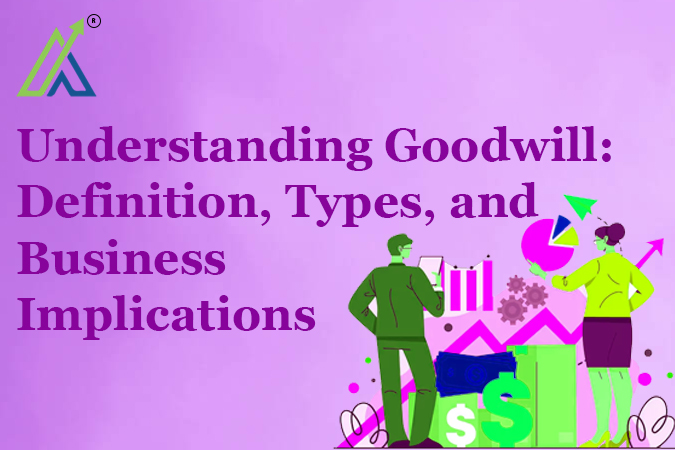In the world of business and finance, goodwill is a term that often surfaces during mergers, acquisitions, and valuations. While it may sound abstract, goodwill plays a pivotal role in reflecting a company’s intangible value beyond its physical assets. This blog explores the definition of goodwill, its various types, and why it matters to investors, accountants, and business leaders.
What is Goodwill?
Goodwill is an intangible asset that arises when one company acquires another for a price higher than the fair market value of its identifiable net assets (tangible assets minus liabilities). It represents non-physical value drivers such as:
- Brand reputation
- Customer loyalty
- Employee expertise
- Strategic partnerships
- Proprietary technology
Types of Goodwill
Goodwill can be categorized into distinct types based on its origin and nature:
- Purchased Goodwill
Purchased Goodwill is an important concept in accounting, particularly in the context of business acquisitions. Here’s what it entails:
- Definition: Generated through business acquisitions. This is the only type recognized in formal accounting.
- Example: When Microsoft acquired LinkedIn for $26.2 billion in 2016, a significant portion of the purchase price was allocated to goodwill, reflecting LinkedIn’s user base and brand value.
- Accounting Treatment:
- Recorded on the balance sheet as an intangible asset.
- Subject to annual impairment tests (under IFRS and GAAP) to ensure its value hasn’t declined.
- Internally Generated (Inherent) Goodwill
Internally Generated (Inherent) Goodwill represents the value created by a company over time through various factors such as brand reputation and customer loyalty. Here’s how it is understood:
- Definition: Value built organically over time through reputation, customer satisfaction, or innovation.
- Example: Apple’s brand loyalty, cultivated through decades of product excellence.
- Key Point: Not recognized in financial statements due to accounting conservatism. Only purchased goodwill is recorded.
- Business Goodwill vs. Personal Goodwill
Business Goodwill and Personal Goodwill are distinct concepts that differ in their association with the company or individual. Here’s an overview of each:
- Business Goodwill:
- Tied to the company itself (e.g., Coca-Cola’s global distribution network).
- Transferable to new owners during a sale.
- Personal Goodwill:
- Linked to an individual (e.g., a celebrity founder’s reputation).
- Often non-transferable, making it less relevant in acquisitions.
Example: A law firm’s value (business goodwill) vs. a star lawyer’s client relationships (personal goodwill).
- Negative Goodwill
Negative Goodwill is a less common occurrence in acquisitions, typically arising under specific circumstances. Here’s what it entails:
- Definition: Occurs when a company is acquired for less than the fair value of its net assets.
- Causes: Distress sales, fire sales, or market downturns.
- Accounting Treatment: Recognized as a gain in the acquirer’s income statement.
Accounting for Goodwill
Goodwill accounting involves specific processes for recognition and testing its value over time. Here’s how goodwill is treated in financial statements:
- Initial Recognition: Recorded during acquisitions as part of purchase price allocation.
- Impairment Testing:
- Annual reviews assess if goodwill’s value has eroded (e.g., due to poor performance).
- If impaired, its value is reduced, impacting profitability.
- Non-Amortization: Unlike patents, goodwill isn’t amortized but tested for impairment indefinitely.
Standards:
- IFRS (International Financial Reporting Standards): Requires annual impairment tests.
- US GAAP: Allows for qualitative assessments before quantitative tests.
Why Goodwill Matters
Goodwill plays a crucial role in both financial analysis and strategic decision-making. Here’s why it matters:Top of FormBottom of Form
- Valuation Accuracy:Captures the premium paid for synergies, market position, and growth potential.
- Investor Insights: High goodwill may signal overpayment or strategic bets on future growth.
- M&A Strategy: Helps acquirers justify premiums and negotiate deals.
Challenges and Considerations
When accounting for goodwill, several challenges and considerations must be kept in mind. These include:
- Impairment Risks: Economic downturns or failed strategies can lead to write-downs (e.g., Verizon’s $4.6 billion impairment on Oath in 2018).
- Subjectivity: Valuing intangibles like reputation involves estimates, creating room for error.
- Regulatory Scrutiny: Auditors closely examine goodwill allocations to prevent overstatement.
Questions to Understand your Ability
Q1.) What does goodwill represent in an acquisition?
a) Only the physical assets of a company
b) The excess purchase price over the fair market value of net assets
c) The total liabilities of the acquired company
d) The total cash reserves of the acquirer
Q2.) Which type of goodwill is formally recorded in financial statements?
a) Personal goodwill
b) Internally generated goodwill
c) Purchased goodwill
d) Negative goodwill
Q3.) How is goodwill treated under IFRS and US GAAP?
a) It is amortized annually like other intangible assets
b) It is recorded but never tested for value changes
c) It is subject to annual impairment tests instead of amortization
d) It is expensed immediately in the income statement
Q4.) What is negative goodwill?
a) When a company pays a premium for another company’s assets
b) When goodwill is written down due to impairment
c) When an acquisition occurs below the fair market value of net assets
d) When personal goodwill exceeds business goodwill
Q5.) Why is goodwill significant in mergers and acquisitions (M&A)?
a) It ensures that only tangible assets are considered in deal valuation
b) It captures brand reputation, customer loyalty, and strategic advantages
c) It guarantees that the acquired company will always be profitable
d) It prevents impairment losses from affecting financial statements
Conclusion
Goodwill is more than an accounting entry—it embodies the intangible essence of a business’s success. While purchased goodwill is a cornerstone of M&A accounting, understanding its types—from inherent brand value to rare negative goodwill—equips stakeholders to make informed decisions. In an era where intangibles drive 90% of S&P 500 value (per Ocean Tomo), mastering goodwill’s nuances is key to navigating modern business landscapes.
FAQ's
Goodwill is an intangible asset representing the excess purchase price paid in an acquisition over the fair market value of net assets.
Goodwill includes brand reputation, customer loyalty, employee expertise, strategic partnerships, and proprietary technology.
Purchased goodwill arises from acquisitions and is recorded in financial statements, while internally generated goodwill is built over time and not recognized in accounting.
Goodwill is recorded as an intangible asset on the balance sheet and is subject to annual impairment tests instead of amortization.
Negative goodwill occurs when a company is acquired for less than the fair value of its net assets, often due to distress sales or market downturns.
Under IFRS and US GAAP, goodwill undergoes annual impairment testing to assess whether its value has declined. If impaired, its value is written down.
Goodwill reflects synergies, market position, and future growth potential, helping justify acquisition premiums and influencing deal negotiations.
Regulatory scrutiny to avoid overstating asset values, subjective valuation assessments, and impairment concerns are among the difficulties.


